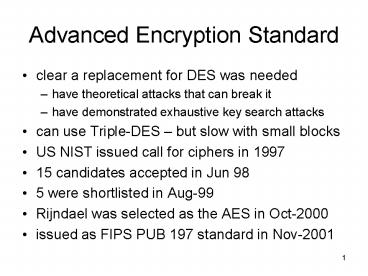Advanced Encryption Standard - PowerPoint PPT Presentation
Title:
Advanced Encryption Standard
Description:
Advanced Encryption Standard clear a replacement for DES was needed have theoretical attacks that can break it have demonstrated exhaustive key search attacks – PowerPoint PPT presentation
Number of Views:162
Avg rating:3.0/5.0
Title: Advanced Encryption Standard
1
Advanced Encryption Standard
- clear a replacement for DES was needed
- have theoretical attacks that can break it
- have demonstrated exhaustive key search attacks
- can use Triple-DES but slow with small blocks
- US NIST issued call for ciphers in 1997
- 15 candidates accepted in Jun 98
- 5 were shortlisted in Aug-99
- Rijndael was selected as the AES in Oct-2000
- issued as FIPS PUB 197 standard in Nov-2001
2
The AES Cipher - Rijndael
- designed by Rijmen-Daemen in Belgium
- has 128/192/256 bit keys, 128 bit data
- an iterative rather than feistel cipher
- treats data in 4 groups of 4 bytes
- operates an entire block in every round
- designed to be
- resistant against known attacks
- speed and code compactness on many CPUs
- design simplicity
3
Rijndael
- processes data as 4 groups of 4 bytes (state)
- best to think of a 128-bit block as consisting of
a 4x4 matrix of bytes, arranged as follows
4
Rijndael (cont)
- Start with an AddRoundKey stage
- has 9 rounds in which state undergoes
- byte substitution (1 S-box used on every byte)
- shift rows (permute bytes between groups/columns)
- mix columns (subs using matrix multipy of groups)
- add round key (XOR state with key material)
- initial XOR key material incomplete last round
- all operations can be combined into XOR and table
lookups - hence very fast efficient
5
Byte Substitution
- a simple substitution of each byte
- uses one table of 16x16 bytes containing a
permutation of all 256 8-bit values - each byte of state is replaced by byte in row
(left 4-bits) column (right 4-bits) - eg. byte 95 is replaced by the value in row 9
col 5 byte - designed to be resistant to all known attacks
6
Shift Rows
- a circular byte shift in which each
- 1st row is unchanged
- 2nd row does 1 byte circular shift to left
- 3rd row does 2 byte circular shift to left
- 4th row does 3 byte circular shift to left
- decrypt does shifts to right
- since state is processed by columns, this step
permutes bytes between the columns
7
Mix Columns
- each column is processed separately
- each byte is replaced by a value dependent on all
4 bytes in the column - effectively a matrix multiplication with results
in the range 0-255
8
Add Round Key
- XOR state with 128-bits of the round key
- again processed by column (though effectively a
series of byte operations) - inverse for decryption is identical since XOR is
own inverse, just with correct round key - designed to be as simple as possible
9
AES Key Expansion
- takes 128-bit (16-byte) key and expands into
array of 44 32-bit words - start by copying key into first 4 words
- then loop creating words that depend on values in
previous 4 places back - in 3 of 4 cases just XOR these together
- every 4th has S-box rotate XOR constant of
previous before XOR together - designed to resist known attacks
10
AES Decryption
- AES decryption is not identical to encryption
since steps done in reverse - but can define an equivalent inverse cipher with
steps as for encryption - but using inverses of each step
- with a different key schedule
- works since result is unchanged when
- swap byte substitution shift rows
- swap mix columns add (tweaked) round key
11
Implementation Aspects
- can efficiently implement on 8-bit CPU
- byte substitution works on bytes using a table of
256 entries - shift rows is simple byte shifting
- add round key works on byte XORs
- mix columns requires matrix multiply in GF(28)
which works on byte values, can be simplified to
use a table lookup
12
Implementation Aspects
- can efficiently implement on 32-bit CPU
- redefine steps to use 32-bit words
- can precompute 4 tables of 256-words
- then each column in each round can be computed
using 4 table lookups 4 XORs - at a cost of 16Kb to store tables
- designers believe this very efficient
implementation was a key factor in its selection
as the AES cipher































